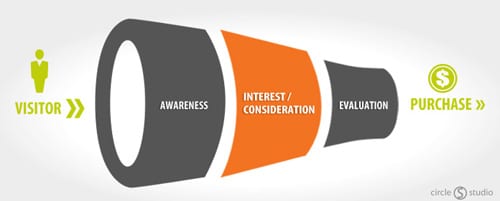So you’re effectively driving traffic to your website using blogging, SEO and social media. And once you get the traffic, you’re converting visitors into leads through effective lead generation strategies that prompt visitors to take action. But now what?
Driving traffic and generating leads is only half the battle and some might argue it’s the easier half. Because remember, the end goal isn’t a database full of names and email addresses or even hundreds of whitepaper downloads; the end goal is new business and paying customers.
The B2B sales cycle can be a long journey
The reality is, most qualified leads aren’t ready to buy, but they will be at some time in the future. Statistics suggest that somewhere between 30% to 50% of the leads that enter a pipeline represent future opportunities. But, for whatever reason, these leads are not yet ready to buy.
And what about unqualified leads? Research from SiriusDecisions suggests that 80% of prospects deemed “bad leads” by sales teams go on to buy within 24 months.
The sales cycle for B2B buyers is typically extended, especially for major purchase decisions. And along that journey, today’s B2B buyers are doing extensive online research, long before they are ready to speak to a salesperson or make a purchase.
Stay engaged with prospects throughout the journey
With a longer sales cycle and heavy competition, B2B companies need to formalize a digital lead management process in order to take advantage of all the leads they are currently generating from their website. Getting that initial conversion is rarely enough to close the deal. What is needed is consistent, timely and relevant communication and engagement.
According to a Genius.com study, 66% of buyers indicate that “consistent and relevant communication provided by both sales and marketing organizations” is a key influence in choosing a solution provider.
And what about “hot” leads that request a quote or another sales-related inquiry? InsideSales.com found that 35-50% of sales go to the vendor that responds first.
Lead nurturing helps educate leads and push them closer to the sale
Lead nurturing is the process B2B marketers use to “nurture” relationships with leads who aren’t yet ready to buy, in order to win their business in the future when they are ready to make a purchasing decision.
The idea is to stay engaged with these leads through each stage of the buying cycle, moving them towards a purchase. By providing valuable information that leads need in order to make a purchasing decision, you’ll stay top of mind and be there when they’re finally ready to commit to buying.
One of the primary ways to nurture leads without being intrusive or overbearing is through setting up lead nurturing email campaigns. These “drip” campaigns are set up to be related to the initial topic of interest and send a series of automated emails at scheduled intervals to qualified, but not sales-ready leads. According to a recent SilverPop/DemandGen Report, lead nurturing emails get 4-10 times the response rate of standalone email blasts.
Lead and prospect intelligence helps you stay in the know
Basic website analytics provides a lot of valuable information, but not necessarily the kind of information that your sales team needs or can use on a daily basis. Website visitor tracking is a common feature found in marketing automation software and helps you go beyond page views to get real-time marketing and sales intelligence.
Marketing automation software allows you to track the following analytics about leads:
– Who is visiting your website
– When they are visiting
– Pages they are viewing
– Content they are downloading
– Campaign response rates (i.e. email opens, clickthroughs, etc.)
Understanding the interests of your leads helps you to be more targeted and relevant and offer the right content in the right context.
Lead scoring helps you focus on the best opportunities
MarketingSherpa defines lead scoring as “the process of adding and subtracting points to a lead’s value over time based on various lead attributes or demographics, and behaviors.”
Typically, your ideal customers fit certain profile characteristics such as job title, industry, etc. and also follow similar steps on their buying journey. Lead scoring is the process of determining what those characteristics and steps are and assigning point values for each.
Utilizing marketing automation makes lead scoring not only easy to do, but also incredibly effective. Each lead gets profiled and their actions are tracked and a score value is assigned to each one in real-time. This allows your sales and business development team to determine sales-readiness and know which leads might be the best opportunities to focus on.
CRM integration helps you close the loop between marketing and sales
While marketing automation is a must-have tool for B2B marketers, a solid customer relationship management (CRM) system that integrates with your marketing automation platform is equally important. There is often a break in communication between marketing and sales teams in many B2B organizations, but when marketing automation and CRM are integrated, the result is a closed-loop between marketing and sales.
This integration allows sales and business development teams to see all of the valuable lead intelligence gathered by the marketing automation platform, send marketing-approved emails and ultimately track every single action and touch point with both leads and customers—without ever having to leave the CRM interface.
/ / /
Qualified leads need to be engaged after their initial conversion and nurtured through each stage of the buying cycle. Gartner Research found that companies that automate lead management see a 10% or greater increase in revenue in 6-9 months. While this is no easy task, utilizing marketing automation and CRM software make lead management much more effective (and easier).




